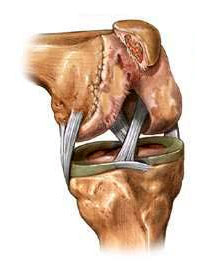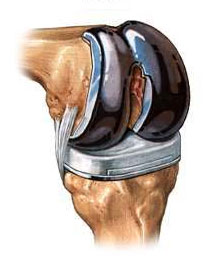Total Knee Replacement
Total knee replacement or Total knee arthroplasty is the surgical procedure of removing damaged and worn knee out and replacing it with an artificial mechanized prosthesis made up of quality polymers.
In case of a damaged knee, the patient is in pain even while carrying out simple activities daily, such as, walking, climbing a stair, kneeling and even sometimes in just lying down. When all other non-operative medications fail to help deteriorated knees and therefore patient’s lifestyle – after careful examination of X-rays and weight and other medical conditions, surgeons might suggest undergoing Total knee arthroplasty.
First ever total knee replacement surgery happened way back in 1968, and ever since this medical field with new technological advancements is growing and have become one of the most successful surgeries performed today in medical arena. Agency for healthcare and research, duly cites that, each year around 600,000 people undergo Knee replacement surgery in US itself. According to a report of The Lancet, 97 percent of the people who undergo knee replacement surgery, record a great deal of substantial improvement in their lifestyle, and have a successful run of 15 years.
If you have been thinking of getting your knees replaced, then this article would help you understand a bit about the knee replacement arthroplasty.
Pre Knee Replacement

Post Knee Replacement

CAUSES
There are number of reasons which can cause severe or debilitating knee pain, but prime reason for knee pain is arthritis. There are three main types of arthritis – Osteoarthritis, Rheumatoid Arthritis and Post-traumatic Arthritis. :
1. Osteoarthritis- It is ‘wear and tear’ type of arthritis. This is common in older people, as the tissues get worn out after a certain age – depending on the kind of activities one does daily and the weight or impact the knees suffer. Knee bones need cushion in the form of cartilage, and when that cartilage wears out, the debilitating pain starts in plain and simple activities.
2. Rheumatoid Arthritis –It is ‘inflammation’ type of arthritis. The synovial membrane which surrounds the knee joint becomes thickened and inflamed. This inflammation leads to sometimes the cartilage loss and pain and stiffness.
3.Post-traumatic Arthritis – This is a serious knee injury. In this type of arthritis, the articular cartilage and tissues are at risk. Fractures of the bones lead to loss of articular cartilage over time, causing knee pain.
DIAGNOSIS
Before advising to opt for knee arthroplasty, the surgeon needs to diagnose the knee condition, evaluate other alternatives and have a look at medical history and various other things to see if the patient needs total knee replacement or not. It is a surgical procedure which requires attentiveness and medical history of the patient must be checked by the surgeon, to see, if the surgery can’t have any side effects.
Thus, the orthopaedic evaluation, consists of –
- 1. General surgeon will gather information about patient’s health and measure patient’s knee pain and the treatment alternatives.
- 2. Surgeon would assess the knee joint physically by knee motion, stability, strength, alignment.
- 3. X-rays are used most efficiently to judge if the knee joint needs a replacement or alternate medications are better suited.
- 4. Sometimes, MRIs and blood tests are conducted to assess the condition of blood near joint and soft tissues.
All these tests and examinations will go into evaluations of the treatment option – best suited for the patient. If the total knee replacement is the best treatment option for you then, the surgeon will prepare you for that.
In addendum, surgeon will take you through the potential risks affiliated with the process and will explain to you on what to expect from and after the surgery.
PROCEDURE:-
After the preliminary round of medical evaluation – which includes Physical assessment, X-rays, medications and urinal evaluation.
Total knee arthroplasty is one of the most successful yet subtle surgical process. It requires precise hands of experienced surgeons. The patients are usually admitted to the hospital on the day of surgery.
The procedure takes about 1-2 hours to complete. The orthopaedic surgeon removes the cartilage and joints and replaces it with the plastic mechanized component, to restore and align the knee.
It starts with anaesthesia provided to the patients. Then, the knee joint area is incised – as deep as 8-10 inches, knee bent on 90 degrees and the worn-out cartilage is removed out. Now, the back of patella is resurfaced with the insertion of plastic component. A flexible cushion usually made of polyethylene called spaceris attached above the tibia surface in order to absorb shocks between the two prosthetic surfaces.
RISKS AND COMPLICATIONS:-
Total knee replacement surgery has emerged as the most viable options for persons suffering with severe arthritis (osteoarthritis). Total knee replacement surgery also known as total knee arthroplasty involves replacement of natural knee with mechanized parts made of alloys known as prosthesis. Most of the patients who opt for total knee replacement surgery end up happy with their lifestyle greatly improved. Albeit it is the most effective method for treatment of chronic arthritis, yet a range of early complications may arise after total knee replacement surgery. The rate of complications from total knee replacement is in the range of 1.65-11.3%.
Stiff Joint – This is the most common issue among patients who have their knee replaced. The degree of stiffness of knee joints depends on the movability before the total knee replacement surgery. Treatment for this is aggressive therapy in early stages to avoid stiffness of the knee.
Infection – It is the most feared complications after total knee replacement concerning patients and doctors.Theincidence of infection is reported in less than 1-2% of cases of primary knee arthroplasty and 3-5% in revision knee replacement.
Blood Clot – Blood clots occurs in the veins of leg and they cause swelling and pain in the knees. In some cases, these clots may move up through veins to the lungs and lead to a life-threatening phenomenon known as Pulmonary embolism. This severe issue is also termed as Deep Vein Thrombosis.
Surgeons provide patients with blood thinners before surgery to avoid clotting as much. After the surgery anticoagulation therapy is used to cure patients with DVT.
Frequently Asked Questions
Total knee replacement also known as Total knee Arthroplasty, is a surgical technique in the field of orthopaedics – used to relieve people with debilitating knee pain and provide better life. This is done by replacing the worn-out cartilages of the knee joint with plastic and mechanized part known as prosthesis. It is one of the most successful surgery in the orthopaedic as well as medical field. The Lacet reports that 97 percent of the operated patients are leading a happier life.
Knee replacement surgery is usually required when there is severe pain the knee joint because of the ‘worn out’ tissues or some damaging accident even while sitting and lying down. Mostly, the cause of knee pain is osteoarthritis. The amount of swelling, pain and other medical conditions history goes into the consideration, if the person needs knee replacement.
Of all the joint replacement operations, knee replacement is the most painful. Pain varies from one person to other as no knees are same. Even, the right and left knees can see a difference in pain. Though the pain is not achy or arthritic, it is the adjustment of the prosthesis with body parts.
TKR – Total knee replacement, is suggested for those patients whose patellofemoral kneecap is damaged along with the cartilage bones. Those arthritic patients who have got only their kneecap damaged are advised for Partial Knee replacement.
Knee replacement surgery is one of the most successful surgeries in medical field. Implants usually last for more than 20 years or so. According to the “The Lacet” – only 3.9% of people having implants required revision after 10 years and only 5% of people over 70 needed revision surgery.
So, implants are durable and its termed as life-altering surgery by the happy patients.
Knee replacement surgery is aimed to relieve a person from the debilitating pain, he is in and ease out his efforts and suffering in doing basic simple activities like walking, climbing stairs etc.
Therefore, Knee replacement offers an alternative lifestyle to people suffering with severe arthritic pain.
Recovery after knee replacement surgery is a herculean task. If not heeded proper attention, rehabilitation may turn out far-fetched nightmare and thus it requires active participation of the patients and Physiotherapists.
Dos – Using Ice and heat. Go through rigorous Training for recovery.Allowing proper relaxation time.
Don’ts – Do not put extra stress on your knees. Do not undergo any other surgical operation during recovery process, Consult your doctor before taking any other kind of medication
